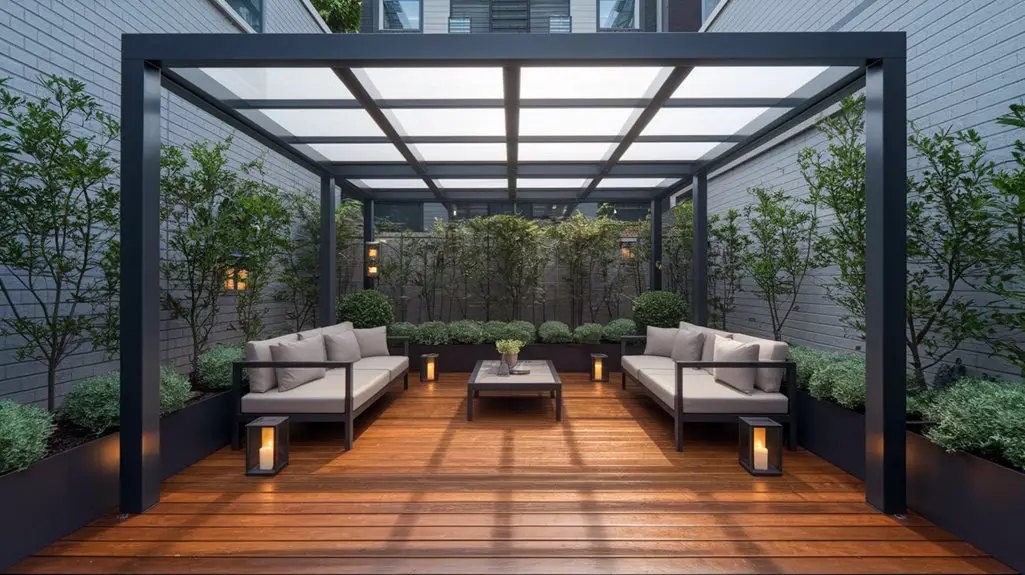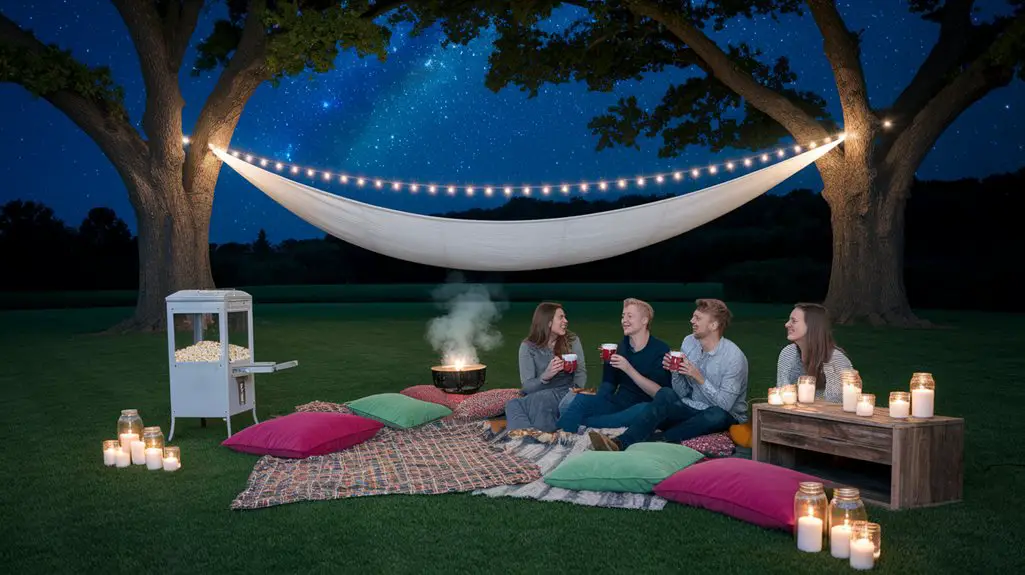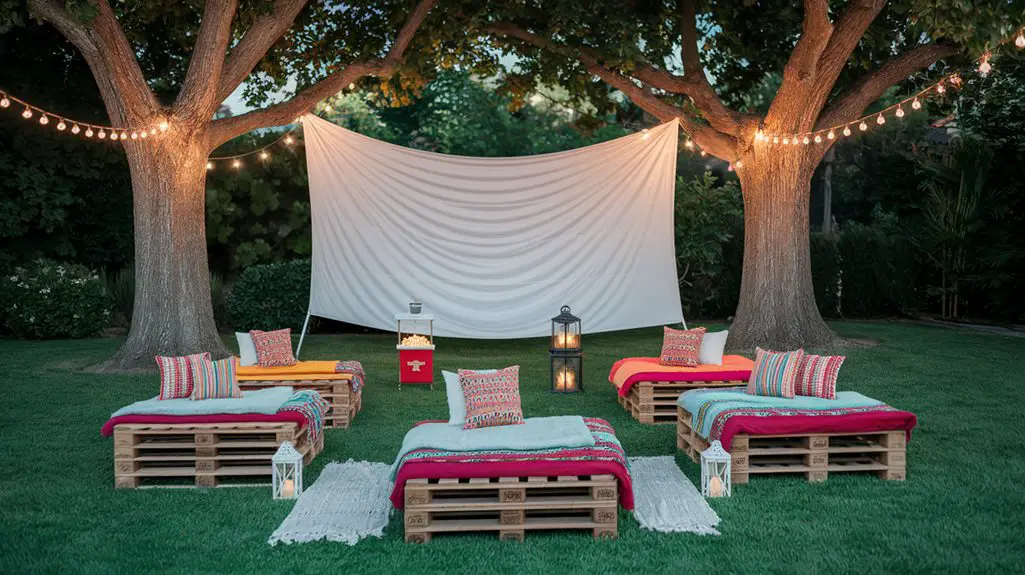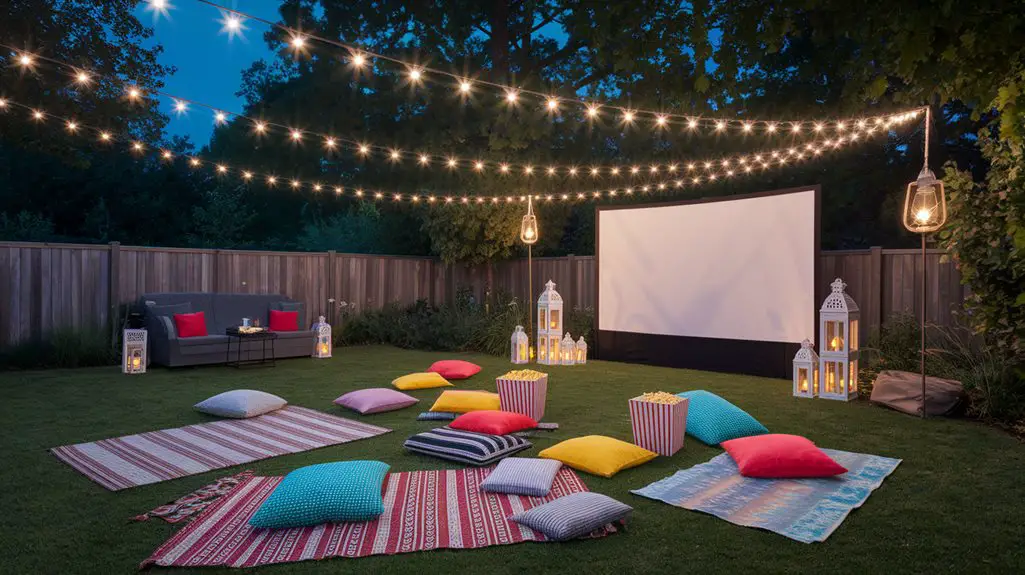You're working with limited square footage, but that doesn't mean you can't create a stunning outdoor retreat. Modern pergolas offer the perfect solution for small backyards when you approach the design with intention. By considering wall-mounted options, multi-functional elements, and vertical space utilization, you'll transform even the tiniest outdoor area into a contemporary oasis. The key lies in understanding how materials, proportion, and strategic placement can redefine your compact space.
Space-Saving Pergola Layouts for Compact Yards
How can you create a stunning pergola when space is at a premium? Consider wall-mounted designs that extend from your home's exterior, eliminating the need for front support posts.
These cantilever structures maximize floor space while providing essential shade.
L-shaped corner pergolas utilize awkward yard angles, transforming dead space into functional areas.
For extremely tight spots, opt for a minimalist pergola with slimline posts and an open-rafter design that won't overwhelm the visual plane.
Incorporate vertical gardening elements with integrated trellises for climbing vines like jasmine or clematis.
These plants provide natural shade without consuming ground space.
Multi-functional components—bench seating with hidden storage, fold-down tables, or retractable canopies—offer flexibility without permanent spatial commitments. Additionally, consider incorporating multifunctional pergolas that can enhance usability and aesthetics in small outdoor spaces.
Multi-Functional Pergola Designs for Limited Space
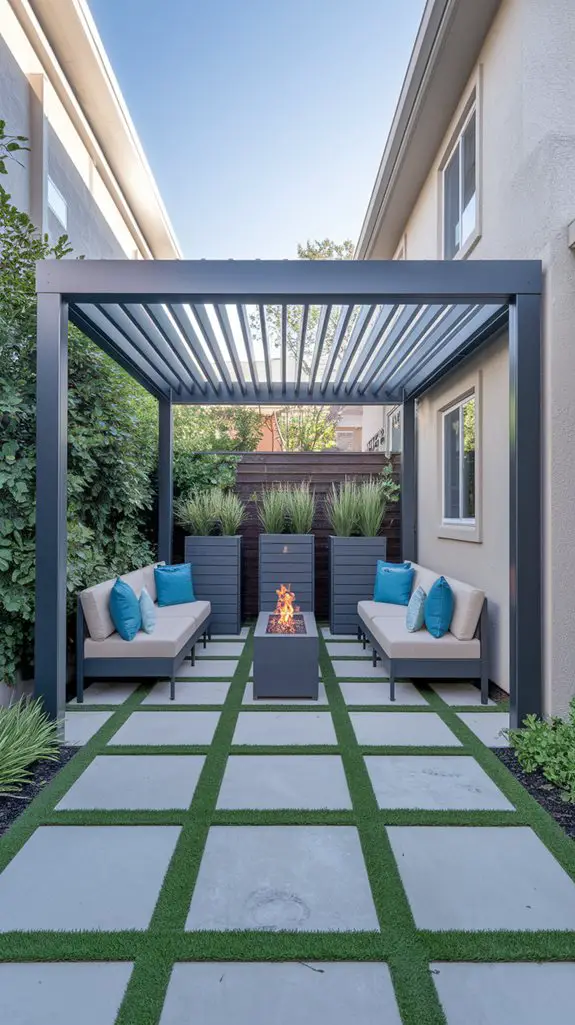
When square footage comes at a premium, why limit your pergola to a single function? Today's compact designs serve multiple purposes simultaneously, maximizing your outdoor living potential. Consider integrating these dual-purpose elements into your structure. You'll transform a simple shade cover into a complete outdoor living hub without sacrificing precious garden space.
| Feature | Function |
|---|---|
| Built-in benches | Seating + storage |
| Retractable canopy | Sun/rain protection + light control |
| Climbing plant trellis | Privacy screen + vertical garden |
| Fold-down side table | Dining space + space-saving when closed |
| Integrated lighting | Evening illumination + ambiance creator |
Position your multi-functional pergola where sight lines extend beyond its footprint, creating visual depth that makes your limited space feel more expansive. Additionally, including charming outdoor seating can enhance the overall comfort and utility of your backyard.
Material Selection for Sleek, Modern Aesthetics
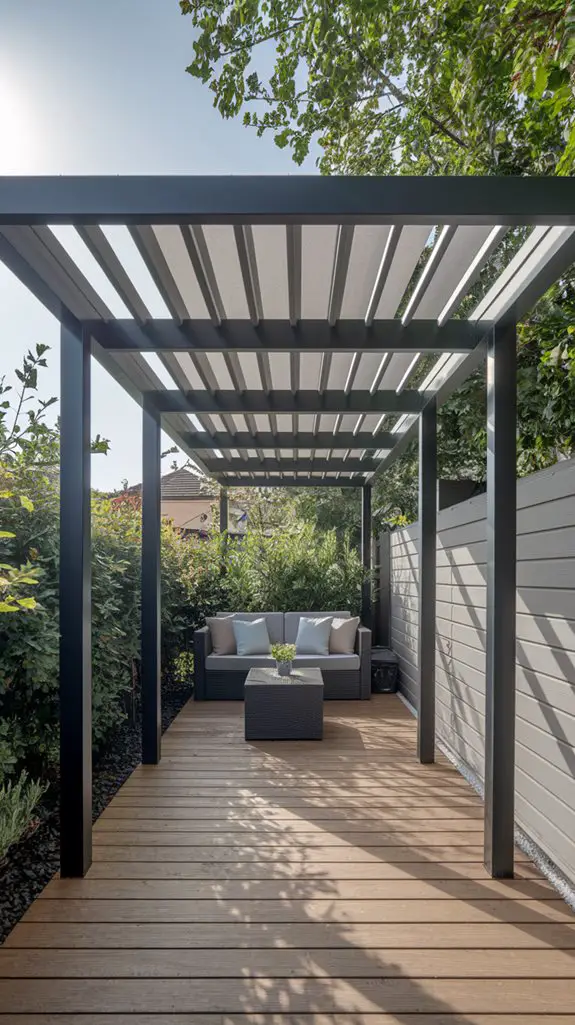
Material selection forms the foundation of any modern pergola's aesthetic appeal. For sleek, contemporary designs, consider powder-coated aluminum or steel frames in matte black, charcoal, or bright white. These metals offer durability while maintaining a slim profile that won't overwhelm limited spaces.
Cedar and redwood provide natural warmth but require regular maintenance. For minimal upkeep, explore composite materials that mimic wood's texture without the weathering concerns. Glass or polycarbonate panels create clean sight lines while offering protection from elements.
When pairing materials, contrast metal frames with warm wood slats or integrate tempered glass with steel connections. Consider how materials interact with existing architecture—aluminum complements modern homes, while wood better suits traditional settings. Additionally, incorporating eco-friendly landscaping practices can enhance the sustainability of your pergola design.
Remember that proper material selection enhances spatial flow while establishing your pergola as a deliberate design element rather than an afterthought.
Maximizing Vertical Space With Climbing Plants
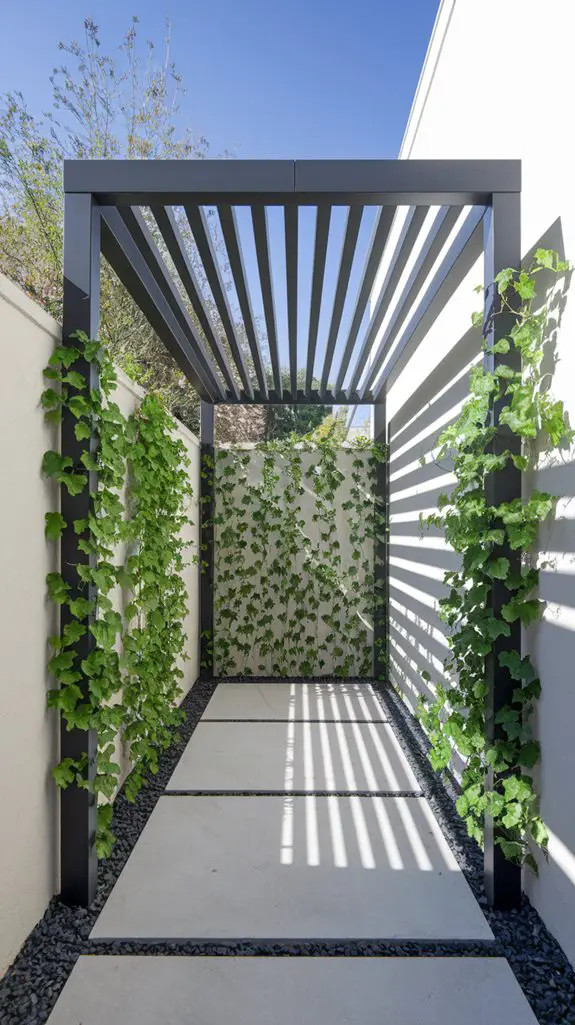
Vertical surfaces of your pergola offer untapped potential that climbing plants can transform into lush, living architecture.
Select varieties based on growth patterns: wisteria and grape vines create dramatic canopies, while jasmine and clematis offer delicate coverage with minimal structural stress.
Install stainless steel cables in grid or horizontal patterns 6-8 inches from the pergola frame to provide climbing support without compromising the clean lines of your modern design.
Position containers strategically at pergola posts, using self-watering systems to minimize maintenance.
For year-round interest, combine deciduous and evergreen climbers like silver lace vine and star jasmine.
In tight spaces, opt for vertical espaliered plants that grow flat against surfaces.
These living walls create privacy while drawing the eye upward, making your compact outdoor space feel expansive. Additionally, incorporating low-maintenance landscaping features can enhance your backyard's aesthetic without demanding excessive upkeep.
Integrated Lighting Solutions for Small Pergolas
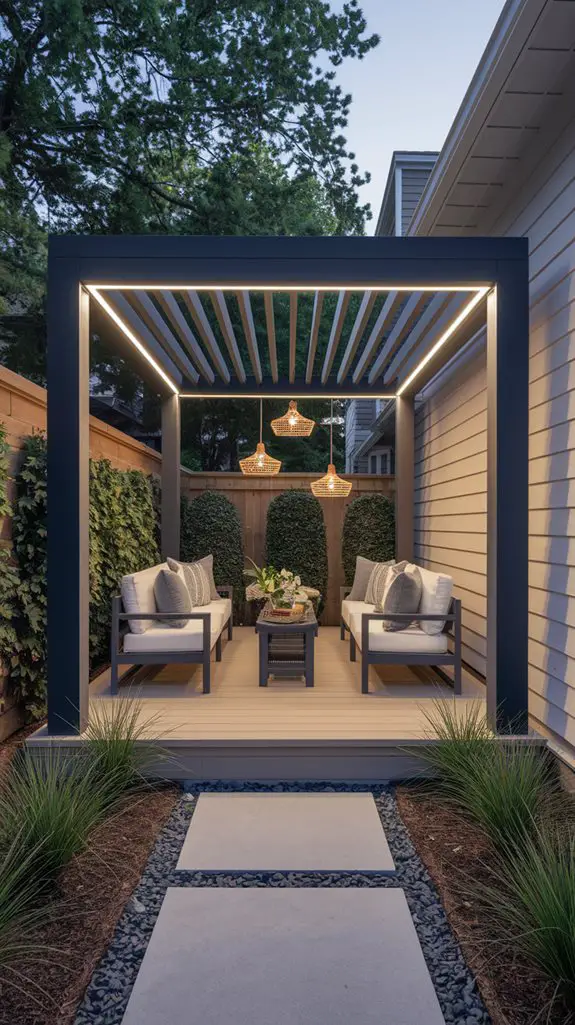
Thoughtful lighting transforms even the smallest pergola from a daytime retreat into an enchanting nighttime sanctuary.
Install low-voltage LED strips along interior beams to cast a subtle glow without overwhelming the intimate space. Position these fixtures 8-10 inches apart for consistent illumination without harsh shadows.
Consider recessed downlights at crossbeam junctions to highlight seating areas or architectural features. For plant-integrated structures, use upward-facing spotlights to illuminate climbing vines, creating dramatic silhouettes against the pergola's frame.
Weather-resistant string lights can be woven in zigzag patterns across the top for ambient illumination. Choose fixtures with color temperatures between 2700-3000K for a warm, inviting atmosphere.
Remember that small spaces need less illumination—aim for 20-30 lumens per square foot to preserve intimacy while ensuring functionality. Additionally, incorporating creative shade structures can enhance the overall aesthetic appeal of your outdoor space.
Weather-Resistant Features for Year-Round Enjoyment
Beyond illuminating your outdoor haven, creating a pergola that withstands nature's elements expands its usability throughout changing seasons. Consider installing retractable waterproof canopies that provide instant protection during sudden rainfall while preserving openness on clear days. For winter durability, select cedar, redwood, or pressure-treated pine with marine-grade sealants applied biannually. Position your structure to account for prevailing winds, installing windbreaks on vulnerable sides using tempered glass panels or weather-resistant fabric screens. Integrate drainage channels along beams to prevent water accumulation, and slope your flooring at 1-2% for proper runoff. For cold climates, incorporate infrared heating panels discreetly mounted between rafters, consuming minimal space while maximizing thermal efficiency. Complement with cold-hardy climbing plants like winter jasmine that maintain structure while offering seasonal interest. Additionally, investing in custom shade solutions can enhance comfort and style, making your outdoor space more inviting.
Connecting Indoor-Outdoor Living With Strategic Placement
The perfect pergola serves as a spatial bridge between your home's interior and the surrounding landscape when strategically positioned.
Consider sightlines from key windows and doors, aligning your pergola to create visual continuity that draws the eye outward.
Position your structure within 10-15 feet of sliding doors or kitchen windows to establish a functional connection zone. You'll maximize this connection by matching floor heights where possible and using complementary materials—cedar pergolas pair beautifully with interior wood tones.
Plant climbers like wisteria or clematis strategically along the structure's perimeter, creating living walls that soften boundaries while maintaining sight connections.
For small yards, consider an attached pergola with a semi-transparent polycarbonate roof section nearest the house, allowing light penetration while extending your usable outdoor season regardless of weather. Incorporating functional outdoor kitchen designs can further enhance your outdoor living experience, making it a versatile space for cooking and entertaining.
Budget-Friendly Modern Pergola Options for Tight Spaces
Modern pergola design doesn't require vast spaces or extravagant budgets to create impressive outdoor sanctuaries.
Consider freestanding aluminum models that weigh less and cost considerably less than traditional hardwood structures, while offering similar visual appeal with proper finishing.
Utilize vertical space by incorporating wall-mounted pergolas that extend just 4-6 feet from your house, requiring only two supporting posts instead of four.
These half-structures deliver full functionality at nearly half the cost.
Modular pergola kits provide excellent value, allowing you to expand gradually as your budget permits.
Look for systems with slim-profile beams that maximize headroom without sacrificing structural integrity.
For ultra-tight spaces, explore cantilevered designs that eliminate ground posts entirely, or investigate retractable canvas pergolas that install on existing walls and provide adjustable shade at a fraction of hardwood construction costs.
Additionally, consider integrating rustic outdoor kitchens into your pergola design for a cohesive and inviting atmosphere.
Conclusion
When you position a modern pergola in your small backyard, you're creating both structural definition and spatial illusion. Though you might worry about overcrowding your limited square footage, a professionally designed pergola actually enhances perceived space through vertical extension. Integrate drought-tolerant climbers like jasmine or clematis on cable systems rather than solid panels. You'll maximize your outdoor living potential while maintaining proper airflow and light penetration—transforming your compact yard into an architectural extension of your home.

